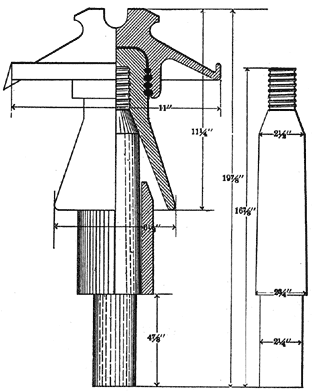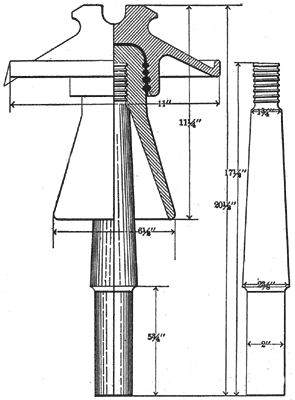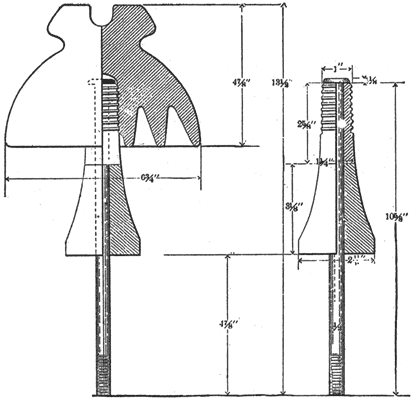[Trade Journal]
Publication: Western Electrician
Chicago, IL, United States
vol. 32, no. 16, p. 304-305, col. 1-3,1
Power Transmission on High-tension Lines.
PART III.
BURNING OF WOODEN PINS ON HIGH-TENSION
TRANSMISSION LINES.
BY C. C. CHESNEY.
Almost the uniform practice in this country in high-tension pole-line construction has been the use of wooden pins. The reason for their use has been the belief that because they were made of wood they strengthened the entire insulation of the pole-line system, and were in consequence additional safeguards. These pins have generally been made of locust, oak or eucalyptus, and in order that the insulation might not deteriorate from the action of the weather, they have usually been treated carefully with hot asphaltum, paraffine or linseed oil. The temperature and character of the treating liquid have depended more or less upon the whim of the constructing or designing engineer. Although there has been no uniform method followed and although the materials used in the treatment have differed greatly, the results have been universally the same. Wood pins when used with glass or well-vitrified porcelain insulators, have given very good service on potentials as high as 25,000 or 30,000 volts. There have been no unusual pin troubles, at these voltages which could not readily be explained by porous or cracked insulators or by some peculiar climatic conditions. In my opinion, the success secured in the operation of the great majority of these lines is due to good insulation of the insulator, and the insulation of the pin has in reality contributed very little to that success. For 40,000 volts and for higher potentials, the insulators offered by all manufacturers do not have the same factors of safety as the insulators for lower voltages offered by the same manufacturers. The difference is not so much in the thickness or in the quality of the glass or porcelain used; it is more particularly m the general shape of the insulator and in the dimensions of the insulating surfaces and petticoats. For this reason, even under severe local surroundings, the 10,000, 15,0000, 20,000 or 30,000-volt insulators have shown very little surface leakage, and in consequence there has been comparatively little pin burning at these voltages. It is true that in localities of salt storms, of heavy sea fogs or chemical factories, there has been more or less pin burning without regard to the type of insulator used, or to the potential of the system. The writer has been informed that a certain plant using only 440 volts has at times great trouble from the burning of pins, although 10,000-volt insulators are used. This trouble is due entirely to the deposit on the insulators from a neighboring chemical factory, and as might be expected their period of no-burning is during the rainy season. These instances, however, are rare, and when the cause is apparent, the remedy is usually at hand. The pin burning on 40,000 and 50,000-volt lines is somewhat different. Eliminating all causes due to broken or defective insulators, the actual flow of current over the surfaces and through the body of the pin is probably very small.
 |
| Fig. 7. High-Tension Lines. — Eucalyptus Pin. |
On the lines from which the writer has secured burned pins two used 11-inch Locke insulators, as shown in Figs. 7 and 8; the third used the Redlands type, Fig. 9. The first two lines were operated at a potential between 45,000 and 50,000 volts, and the third at about 33,000 volts. The pins shown were taken from perfect insulators, and in some cases the insulators were immediately put back on the line. Pins (Figs. 7 and 8) were made of eucalyptus and boiled in linseed oil. The line using pin (Fig. 8) also used a porcelain sleeve covering the base of the pin. Fig. 9 shows the well-known Locke iron pin with porcelain base and oak thread. Fig. 10 shows a burned pin of the type shown in Fig. 8. The striking feature of Fig. 9 is the burning of the wooden thread to the iron pin. The writer has been informed by the general superintendent of this plant that every pin that has been examined on this line is burned in exactly the same way, yet there has been comparatively few punctured insulators and no cross-arms burned from the current leaking over the surface of the insulators. The noticeable feature of a pin taken from a 50,000-volt line is that the burned section is entirely in the upper part of the pin, about 1 3/4 inches below the thread. The outside surface and the center of the pin below this point show no charring. It would appear that at least, in this instance, the burned section was the point of highest resistance of the pin, and that the lower part of the pin was a good enough conductor to permit the small current which leaked over the surface of the insulator to flow without any special generation of heat in that section of the pin. The reduced insulation of the pin and insulator was no doubt due to the dust and fog. The upper portion of the pin being better protected by the insulator from fog and dust, had in consequence higher surface resistance. A peculiar action which is occasionally found on high-tension transmission lines has been called "digesting the thread of the pin." The thread of the pin softens while in service and may be rubbed off with the fingers. This soft wood has a sour taste and resembles digested wood pulp. This action is not necessarily accompanied by the burning of any portion of the pin.
 |
| Fig. 8. High-Tension Lines. — Pin on 50,000-Volt Line. |
The evidence here presented, while not conclusive, still points to the advisability of using iron pins with modern insulators properly chosen for the line potential.
DISCUSSION.
M. H. Gerry, Jr.: On a certain number of high-tension transmission lines there has been a burning of the wooden pins. On other transmission lines of high voltage there has been no such burning. Where burning has occurred it has been due to leakage of current from the surface of the insulators, coupled with resistance conditions in the pin such that sufficient heat was developed to char the wood.
Wood is one of the best of insulating materials when thoroughly dry and one of the poorest when containing sap or moisture. The greatest objection to it is its unreliability, due to the difficulty of removing, the last traces of sap or moisture. A thoroughly dry wooden pin, 15 inches in length, will stand indefinitely 100,000 volts of pressure, while a green pin of the same length, containing sap, will break down very quickly under 1,000 volts of pressure. Paraffining the pins on the outside, or coating with asphaltum or linseed oil, is of no value. If the pins are thoroughly, dry, the material in which they are dipped can be made to impregnate the entire body of the wood, thus producing a pin of high insulation. In order to prevent burning of pins, they should have either very high or very low resistance. With insulators having a large amount of surface leakage, such as those illustrated by Mr. Chesney, an iron pin is perhaps the only solution of the difficulty.
 |
| Fig. 9. High-Tension Lines. — Iron Pin With Porcelain Base. |
H. W. Buck, Niagara Falls: In regard to the point which Mr. Chesney spoke of regarding the "digesting of the thread of the pin," I found many pins on the Niagara transmission where disintegration had occurred at the top of the pin and it would crumble into white powder. We recently had some of the powder analyzed by chemists, and they found it to be a nitrate salt, which would look as if nitric acid was found in the static discharge of the pin and had attacked the wood, forming a combination of nitrogen salt. In this connection I want to say that about six months ago we built an experimental single-phase line about two' miles in length, which we operated for five months at 75,000 volts. The conducting wires of the line were iron, tied with copper tie wires. At the end of the five months' test, the galvanized iron had turned black, although the iron guy wires remained in their original bright condition, so that the blacking of the wires was not due to atmospheric conditions. We look down the wire and noticed it was disintegrated on the surface to the depth of several thousandth of an inch. The copper tie wire was digested to a certain depth, though not as much as the iron, which also looks as if a nitrogen compound was forming in a thin film around the conductor at this high voltage, due to brush discharge, and attacking the metal. This indicates some trouble may be experienced when high voltages are used, on account of the formation of the salt due to the well-known action of nitrogen and oxygen in static discharge, thus forming nitric acid with the moisture of the atmosphere and the compound attacking the metal conductor.
 |
| Fig. 10. High-Tension Lines. — Burned Pin. |
Mr. Mershon: This is what happens when the pins burn. The insulator, the lower part of the pin and the cross-arm have their surface resistance lowered by moisture or otherwise, but the upper part of the pin being protected by the insulator does not have its surface resistance so much decreased; the consequence is burning of the protected surface. In some cases the inner surface of the insulator next the pin and the pin itself are so well protected by the insulator that the current, instead of leaking over the surface of the insulator until it reaches a point where the insulator and pin are in contact, jumps in a brush discharge from the edge of the petticoat to the pin rather than follow the higher resistance of the protected surface. As a result the pin is burnt at the point where the brush discharge strikes it instead of at or near the thread. There are apparent three possible remedies for the trouble due to charring pins:
1. Make the design and size of the insulator such that for all conditions its surface resistance will be so high as to control the leakage and keep it below a point which can harm the pin; 2. Make the pins fireproof, but non-conducting; 3. Make the pins conducting.
The remedy recommended in the introduction to this discussion is (3). It is recommended that an iron pin be used. This certainly would do away with the trouble of charring pins, but whether or not it will introduce other and more serious trouble remains to be seen. It seems to me there is a very likely chance of trouble from the use of iron pins due to the unyielding character of both iron and porcelain or glass and their widely different co-efficients of expansion. It would seem better to adopt, the first remedy and make the design of the insulator such as to protect the pins.
Mr. de Muralt: It may possibly be interesting to you to know that while the general practice in America is to use wooden pins, in Europe it is just the opposite, and practically all of the high-potential installations use iron pins, and more than that, while here very often the whole pole is treated with as little iron as possible, in Europe there are quite frequently poles constructed entirely of iron with iron pins; and the only insulation relied upon is the insulation proper. I believe this does away with the burning of pins, cross-arms and poles. I do not think there is very much difficulty in the way of avoiding mechanical strains which have been alluded to several times to-night — with regard to the insulator pin, a way to get around that is to fix the pin into the insulator by means of a cement which will take up any such strain, and in a great many installations that I know of cement made of a mixture of litharge and glycerine has been used with, as far as I know, very good results. It seems to me that it is a very good scheme to lay the entire insulation into the insulator, and then let the rest of the pole take care of itself.
Philip Torchio, New York: Now, it seems to me this Locke insulator, with double petticoat, making the condensers in series and then this oak-thread, porcelain-base iron pin, as shown in Fig. 9, may give rise to that increased potential across the pin to the porcelain, which, might explain the charring of the wood.
C. E. Skinner: I understand that the pins used on that line were selected with the utmost care, and were carefully treated, and that they have had practically no trouble whatever in more than a year's run with a potential of over 50,000 volts. These pins are protected by glass from the weather. We should also keep in mind other things, especially that this is in a different climate from any other installation, and that what is a cure for these troubles in one climate cannot be the cure for other climates.
W. N. Smith.: In the matter of wood and iron pins, it seems to me along with various other elements, the question of cost will govern. Iron poles in this country at this time are anywhere from $30 up, and a wooden pole of suitable size runs from perhaps $7 to $20, according to size and where it can be got. The matter of cross-arms may be governed to some extent by the size selected for the butt of the pin.
Mr. Chesney: I was particularly interested in Mr. Buck's information concerning the digesting of the pin. This has bothered me considerably in a number of cases and on a number of transmission lines. I attributed it to the formation of ozone. I think ozone is usually to blame for all such troubles. If it is nitric acid, I am glad to know it. With regard to the remarks of Mr. Mershon in reference to the use of the wooden thread, as far as I know on the particular line in which the Locke pin with the wooden thread was used, the burning was not serious, and it simply consisted in practically puncturing the wooden thread at one point and stopping, and did not deteriorate any further. In order to relieve the mechanical strain, I think it is quite possible to use a lead thread. Litharge and glycerine have been used to some extent for iron pins in this country, but lately Portland cement has been used in place of litharge and glycerine. I believe on one of the largest new transmission, lines now being erected in Mexico, they are using Portland cement and iron pins, and instead of using iron poles they will use iron towers, having a distance between the insulators of some 400 or 500 feet.
[Prof. W. S. Franklin then read his paper and exhibited a model in regard to the distribution of electromotive force and current along a single-phase alternating-current transmission line, after which the meeting adjourned.]
